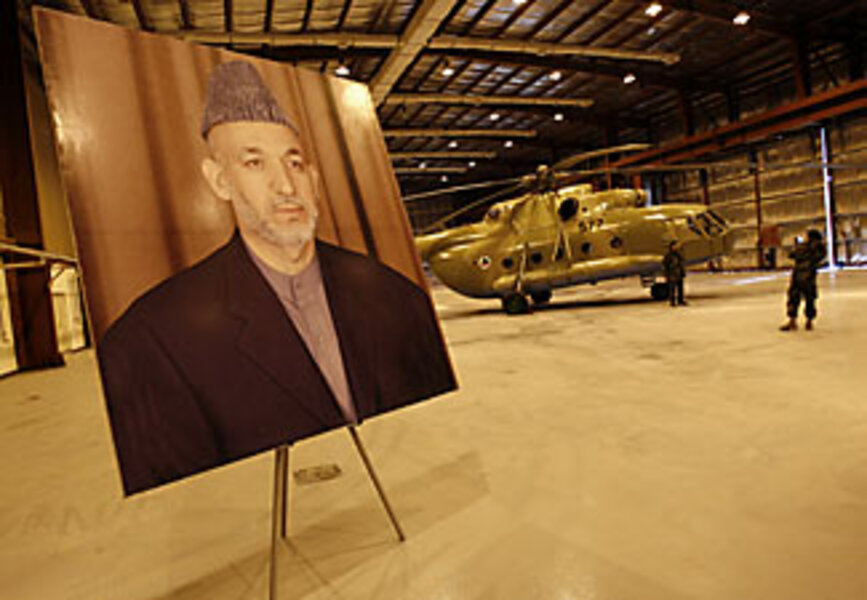Afghan Air Corps takes off, slowly
| Kabul, Afghanistan
Lt. Col. Bryan Harris was not surprised that the Afghan Army's helicopters were punctured by the odd bullet hole. These Soviet-made Mi-17 transports had been the workhorses of more than two decades of unceasing war.
What surprised him was the remedy – not industrial rivets, as American mechanics would use, but old bottle caps.
For Colonel Harris, it was a glimpse of the job ahead. He is here to help Afghans resuscitate their Air Corps – a force that had steadily decayed since its heyday during the Soviet-backed regime of the 1980s.
It is a job with serious implications: The Afghan Army needs an Air Corps to become self-sufficient. But the first order of business, says Harris and others, is to persuade Afghan colleagues to stop scavenging crashed aircraft for spare parts or taking off without even making a flight plan.
"They treat it like it's their car and they're taking it out to the mall," says Col. Todd "Burt" Lancaster, one of the pilot trainers here. "We have to figure out how to change old habits."
They are old habits. The average age of pilots in the Afghan Air Corps is 44.7 years. More than pilots, they are survivors. As different regimes have cycled through Afghanistan, they have remained with their aircraft. In the 1980s they escaped missiles fired by US-sponsored mujahideen. In the early 1990s they outlasted the warlords who brutally fought one another for power. Later they obeyed the often foolhardy commands of the Taliban.
One pilot, Capt. Nazar Mohammad Azizi, was shot down by the mujahideen and held prisoner for two years. Another recounts how the Taliban demanded that a fellow pilot take off with 50 people on board, packed tight as though on a public bus. Too heavy, the helicopter crashed at liftoff.
Still, they flew. "The only reason we are alive is we are pilots – they needed us," says Captain Azizi. "Otherwise we would have been beheaded" for having repeatedly changed sides along with the aircraft they flew.
Now, the goal is to get the Air Corps back to its Soviet-era strength, both in professionalism and capacity. This includes sending some Afghan pilots to the US for training. Azizi smiles when he thinks of the tools American pilots have at their disposal. "I flew 30 hours with night-vision goggles in El Paso, Texas," he says.
Some of those tools will come to the Afghan Air Corps, too. So will scores more aircraft. Today it has 29 – 21 helicopters and eight transport planes. By 2016, that number should be 120 – 60 helicopters and 60 planes, nearing the 200 it had in Soviet times. Likewise, the number of Air Corps personnel is expected to grow from 2,300 to 7,250.
"With the kind of war we have in Afghanistan, it is vital to have air support," says Gen. Abdul Zahir Azimi, an Army spokesman.
That war is an insurgency spread out across a country the size of Texas, with militants moving across remote deserts and hiding amid the jumble of 20,000-foot peaks.
"It's a large country with forbidding terrain, and the roads are not too good," adds Brig. Gen. Walter Givhan, commanding officer of the Combined Security Transition Command – Afghanistan, which runs the training program. "How do you get around? Afghanistan begs for air support."
Already, the Air Corps is flying 90 percent of the Afghan National Army's air-support missions. For the most part, these are not combat missions, but the figures demonstrate increasing capability. Nine months ago, NATO was doing 90 percent of the ANA's air support.
The trainers here don't doubt the Afghans' abilities to carry the load. Despite the collapse of the Soviet regime in 1992 – eliminating millions of dollars in support and training – Afghan pilots and mechanics managed to keep their helicopters flying, sometimes only with bottle caps and scavenged parts.
"Their ability to take anything and make it work is phenomenal," says Colonel Harris, who is training mechanics here. "We're trying to take that natural ability and make it safer and more methodical."
In a bare classroom of fading yellow walls, Colonel Lancaster, a pilot, is trying to do just that. He is one of the 160 active and retired American officers training the Air Corps in Kabul.
He holds a book that includes a list of phone numbers, facilities, and procedures at every airfield in Afghanistan. His hope is that the next time these pilots head to Kandahar, they will read it, too.
An American pilot will not take off without a preflight routine taking no less than 90 minutes – including checking weather forecasts, intelligence reports, and briefing his crew. Afghans, however, are usually off the ground in 30 minutes, says Lancaster.
"On the simplest missions, they can get by with that," says Lancaster. "But they don't have much of a safety net."
Many students are grateful for the lesson. "I appreciate that [the Americans] don't just take off," says Maj. Bakhtullah Bakhtuiar.
Yet there is pride in accomplishing so much with so little. "With bad equipment and little assistance, we have been doing precise missions – flying to mountainsides and other areas of the country," says Azizi.
The admiration is mutual for General Givhan. He speaks in impressed tones when he describes how a helicopter he was in – piloted by an Afghan – came under attack recently. "He had good avoidance techniques," he says, describing the pilot's ability to evade a rocket-propelled grenade fired at the aircraft. "He was completely comfortable."
In this, at least, nothing has changed since the days of the mujahideen: Afghanistan is still at war, and its pilots are in the thick of it. Says Major Bakhtuiar: "This is our profession. We are flying for anyone."
[Editor's note: The original version misstated the name of the Air Corps in the headline.]





